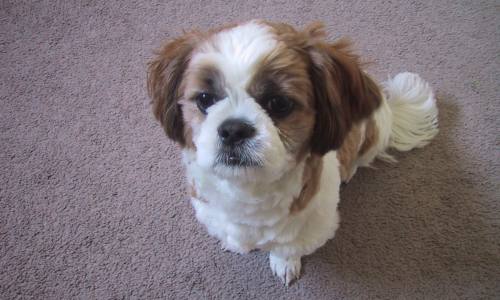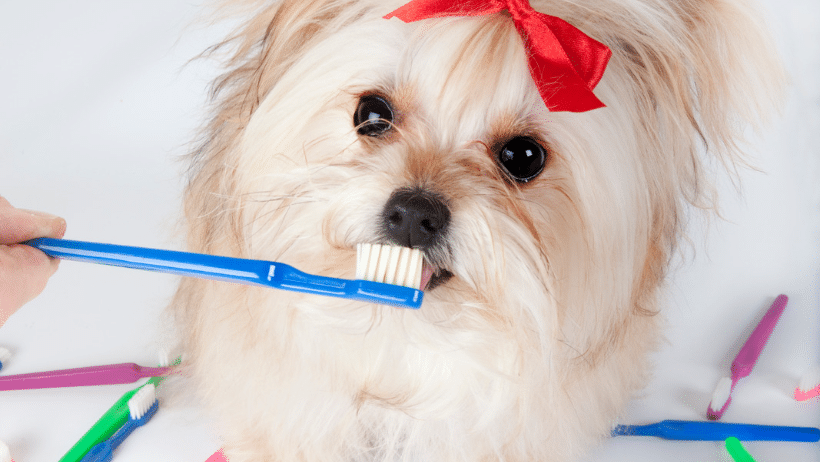
Taking care of your Shih Tzu’s dental health is an important part of keeping them healthy and happy. Starting a dental routine early will help prevent gum disease, tooth decay, and bad breath. Learn all the steps you need to take to keep your pup’s teeth and gums in tip-top shape!
Common dental problems…
– Periodontitis
It is very common among Shih Tzu and all dogs to have gum disease. At the age of two or three, many dogs have either periodontitis or gingivitis. The most common dental problem for canines is periodontitis, also known as periodontal disease. The disease is caused by various factors: plaque, food debris, cell mucus, and a mixture of bacteria. This results in a film characterized by milky-white on the dog’s teeth as well as the gums. When this film gets combined with saliva, the plaque it causes becomes tartar, and is very hard to remove.
– Gingivitis
Gingivitis, also known as gum disease, happens when gum tissue suffers from inflammation. Without treatment, it can lead to periodontitis, teeth loosening, bone loss, and ultimately, loss of teeth.
– Tooth fractures
Tooth fractures occur when Shih Tzu or any dog chews hard substances, such as hard rocks and cow hooves. The fractures result in infection inside the broken tooth, which is known as endodontic disease.
Adult Shih Tzus have 42 teeth, just like all other breeds of dogs. These teeth are divided into four types: incisors, canines, premolars, and molars.
- Incisors: Incisors are the sharp teeth at the front of the mouth. They are used for biting and tearing food.
- Canines: Canines are the long, pointed teeth next to the incisors. They are the sharpest teeth in the mouth and are used for gripping and tearing food.
- Premolars: Premolars are located behind the canines and are used for grinding food.
- Molars: Molars are the largest teeth in the mouth and are located at the back of the mouth. They are used for grinding food.
Shih Tzu puppies are born without teeth and start to develop their baby teeth at around 3 weeks of age. These baby teeth, also known as deciduous teeth, are smaller and less durable than adult teeth. They start to fall out at around 4 months of age and are replaced by adult teeth.
All of the adult teeth should be in place by around 7 months of age. However, it is important to note that some puppies may develop their teeth more quickly or slowly than others.
How to Take Care of a Shih Tzu’s Teeth
It is important to take good care of your Shih Tzu’s teeth to prevent dental problems. Here are some tips:
- Brush your Shih Tzu’s teeth at least 3 times a week. Use a dog-specific toothpaste and toothbrush.
- Give your Shih Tzu chew toys to help clean their teeth and keep them strong.
- Take your Shih Tzu to the veterinarian for regular dental checkups and cleanings.
What Age Do Shih Tzus Lose Their Adult Teeth?
Shih Tzus typically lose their adult teeth between the ages of 4 and 7 months. However, it is important to note that some puppies may develop their teeth more quickly or slowly than others.
How to prevent dental problems
Many people make the mistake of getting their Shih Tzu in the habit of having their teeth brushed every day with a dedicated dog toothbrush and toothpaste. This isn’t necessary! A regular schedule of dental chews, good dental hygiene at home, and annual cleanings from your vet are enough to stay on top of your pup’s teeth and gum health.
Your Shih Tzu can fight off these dental problems by removing the plaque before it actually develops as tartar. How to do it? The most effective way is by brushing the teeth of your Shih Tzu in a mechanical fashion. The brushing would reduce much of the bacteria present in the mouth, not to mention making your Shih Tzu’s breath smell sweeter. Make it a habit of brushing your Shih Tzu’s teeth on a daily basis.
Toothpaste: There are toothpaste products made especially for dogs. Brush your Shih Tzu’s teeth using dog toothpaste. Human
Before you begin brushing your pup’s teeth, make sure to line up the right products. It’s best to use toothpaste that has been specifically designed for canines as it will be easier for them to digest and reduce any chances of irritation. As with humans, there are many different types of toothpaste so take the time to shop around and find one that is suitable for your pup!
When it comes to brushing your pup’s teeth, use only a soft-bristled toothbrush! This will help you avoid irritated gums and make sure that your dog is comfortable during the process. Make sure that you brush their teeth gently, using circular motions along the gumline and at their back molars. If you’re not sure or don’t feel comfortable brushing, a regular dental chew could be an ideal alternative.
Toothbrush: Using a toothbrush in its teeth will take some time for the Shih Tzu to get used to. Let your dog be acquainted and get used to this by putting some garlic salt, mixing the salt with water, and dipping the solution in an old toothbrush. Hold the old brush, and let your Shih Tzu taste and chew it. Your Shih Tzu will start to realize that chewing a toothbrush is and tastes good. Make it a habit a few times, until he feels comfortable brushing with it.
When it comes to brushing your pup’s teeth, use only a soft-bristled toothbrush! This will help you avoid irritated gums and make sure that your dog is comfortable during the process. Make sure that you brush their teeth gently, using circular motions along the gumline and at their back molars. If you’re not sure or don’t feel comfortable brushing, a regular dental chew could be an ideal alternative.
Finger brush: You could also use a finger brush instead of a toothbrush. A finger brush is a good alternative, although nothing could replace a good toothbrush. The finger brush just fits onto one’s fingertip and can let you brush the Shih Tzu’s teeth without the dog knowing it. Well, at least almost. The disadvantage of getting a finger brush to clean your Shih Tzu’s teeth is that its bristles are quite large for the brush to go under the gum line’s margin as effectively compared with a regular toothbrush.
Once you have the right toothpaste and toothbrush for your pup, it’s time to get brushing! Always start on the outside of the teeth first, using gentle circular motions around each individual tooth. Applying too much pressure can be harmful to their gums, but this circular motion will provide a thorough and effective clean while still being gentle. Make sure to brush all sides of every tooth, both top and bottom, as well as an extra minute or two on the molars which are most likely to accumulate plaque.
Professional cleaning: If you don’t want to do the cleaning by yourself, you could take your Shih Tzu to a veterinarian and have his teeth professionally cleaned. A good veterinarian will take additional measures in ensuring your Shih Tzu’s clean teeth by anesthetizing your Shih Tzu, scraping the buildup of plaque from all over the gum line areas, and polishing the teeth for a sparkling finish.
Home checkup: Try to make it a regular habit of checking the teeth of your Shih Tzu for any cracked or broken teeth. If you see some problematic teeth, check promptly with the veterinarian.
Home safety: Of course, cleaning your Shih Tzu’s teeth does not mean you should disregard other areas of concern. Tough substances, such as bones, rocks, hard nylon, or cow hooves should be removed from areas where your dog could see. Buy your Shih Tzu chewing toys that are safer like rubber-made toys. You could also provide bones that are soft enough for your dog to chew.
Mouthwash: There are some products in the market that deal very well in helping to kill the bacteria in your dog’s mouth and could actually help heal damaged gum tissues. Do not forget to ask your veterinarian about the best products in the market.
Dental problems do not only happen to humans. Shih Tzu and all dog breeds also have dental issues. It is up to the owners how to help their pet dogs overcome their dental problems.
After thoroughly brushing your Shih Tzu’s teeth, you can use floss or dental strips for added cleanliness. This step is important to remove any food particles that may be stuck between your pup’s teeth. Focus on the area under the gum line where plaque accumulates and causes more serious problems if left unattended. If you don’t have either of these items lying around, a cloth dipped in warm water with baking soda can also be used to remove debris from between the teeth.
Legal Disclaimer
This blog post is for informational purposes only and is not intended to be a substitute for professional veterinary advice. If you have any concerns about your Shih Tzu’s dental health, be sure to talk to your veterinarian.




